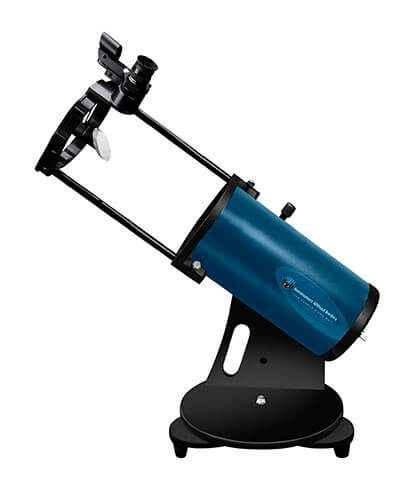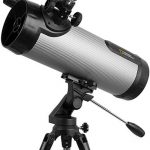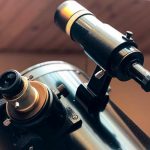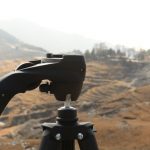AWB Onesky Reflector Telescope Review
If you’re looking for a more hands-on stargazing experience, then this AWB Onesky reflector telescope review will be of real interest. Does the thought of manually collimating the mirrors of a telescope give you a fantastic feeling of accomplishment? Then you’re going to feel at home with the Astronomers Without Borders latest telescope, the Onesky.
AWB Onesky Reflector Telescope
Briefly, the Onesky telescope is a cooperation between Celestron, a major telescope manufacturer in China, and Astronomers Without Borders, a US organization helping developing countries by funding educational programs. They supply astronomy equipment and training that aims to break down cultural and social differences between countries.
They know what it takes to offer telescopes that need to be lightweight and quick and easy to set up with this kind of experience.

Unboxing The AWB Onesky 130 Telescope
When you open the box, the Onesky is almost ready to go for you. Inside the main package, you’ll find a separate smaller box with the red dot finder and three eyepieces. Two of the eyepieces you’ll use to view through the telescope, and the third is there to collimate the scope.
The two viewing eyepieces are 25mm (26x magnification) and 10mm (65x magnification). They are achromat doublet: Kellner 3-lens design with an anti-reflection coating.
The collimation eyepiece is there because reflector telescopes require collimation-aligning your primary mirror with the center of your eyepiece.
The two eyepieces are high-quality optics, but the telescope is good enough quality that some more expensive eyepieces would be worth the investment.
The Onesky itself is a short-focus, tabletop Newtonian reflector telescope with an alt-azimuth mount. Many popular telescopes have a similar configuration, but the Onesky is superior in many details, which we will get to later in this review.
How To Set Up The Onesky Telescope
There’s not a great deal of set up necessary. The red dot finder requires mounting on the top end of the tube assembly. As mentioned, the 25mm eyepiece offers a 26x magnification with a 2-degree field, making it simple to aim the red dot finder at your targets. The 10mm eyepiece works exceptionally well for viewing the moon.
The scope’s optical tube attaches to the mount via a Vixen-style dovetail assembly, locking in place with a hand knob. The dovetail lets you easily balance the telescope on its altitude axis.
There is a screw that fits in the top of the dovetail. The screw is there to prevent the telescope from slipping out of the dovetail mount if it was loose. Once the scope is locked in place, there is a carrying handle on the side for easy transportation.
Design And Mechanics Of The Onesky 130
The Onesky is a 130mm ( just over 5 inches of aperture) f/5 Newtonian reflector. One of the most notable features of this telescope is its 15-inch length. The front section comprises a solid plastic ring that holds the mirror array-secondary mirror, focuser, and finder attached to a metal truss tube. To operate the scope, you push the mirror array to give the full 26 inches working focal length. There are nylon screws on either side of the tube to lock the truss tubes into position.
This style of design, with a collapsing tube, is only as good as its stability. But there are no concerns here. The build quality is robust and sturdy and is excellent at maintaining optical alignment. Even after numerous times collapsing the tube, it still retains the optical alignment without any necessary adjustments.
Usually, there is a 1.25-inch plastic rack and pinion focuser at this price point and telescope design. Still, on the Onesky, this has been replaced by a metal helical focuser that affords a lower profile. An f/5 telescope must have precise fine-focus adjustments, and to have the helical focuser is a bonus.
The alt-azimuth mount is made of wood and is sturdy and robust. The movement was very smooth without requiring any adjustments. There is no problem making fine aiming adjustments even when observing at higher magnifications. Tightening of both the altitude and azimuth bearings is possible if that becomes necessary.
The mount is a tabletop design, so if you want the scope to work to its capabilities, you will need a steady and robust platform or table on which to stand the scope.
Observing with the OneSky 130 Telescope
The Onesky 130 is a sound design capable of reasonably wide fields at low magnification and sharp views on higher magnifications. The two included eyepieces come equipped with a lot of eye relief when viewing, particularly for nearsighted viewers. Where focused image (exit pupil) hits your eye’s pupil.
As discussed, the 25mm eyepiece gives a clear view of nearly 2 degrees at 26 magnification, and while that is excellent for viewing open clusters, a cluster such as the Pleiades won’t fit in the field. If you were to add a 32mm Plossl eyepiece to your collection, then you would get a brilliant view of the Pleiades cluster.
Using the 10mm eyepiece will allow you to see Jupiter’s two main bands and good views of the moon. You could add a Barlow lens as well as a higher power eyepiece would be the better investment. For example, with an 8mm and a 2.5x Barlow, you will be able to view Saturn and the Cassini Division.
The red dot finder is accurate once you know where to find the objects you wish to view. It’s not a finder scope, so it does not magnify.
In Conclusion
The AWB Onesky is a very impressive telescope. The manufacturers have managed to get the significant areas of a telescope spot on. The scope is easy to aim, comes with a decent set of accessories, and has excellent optics. Of course, being a tabletop, it’s portable, but at only 14lbs, it’s lightweight as well. It’s first-rate, and whoever owns one will be mightily pleased they bought the AWB for a beginner’s telescope.
Another great thing about buying this telescope is that AWB put the profits they make from the telescope’s sales back into their efforts to educate and integrate developing countries.



















